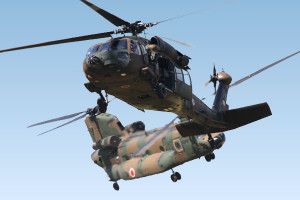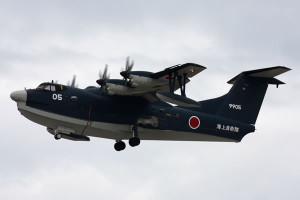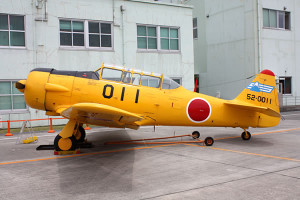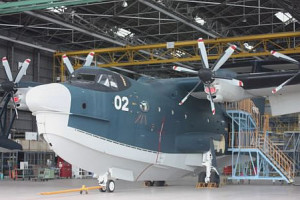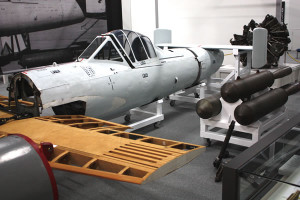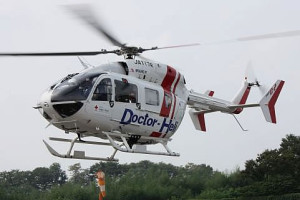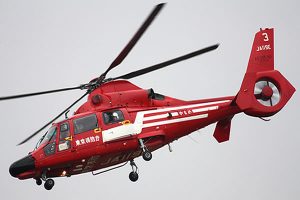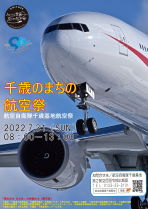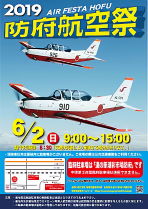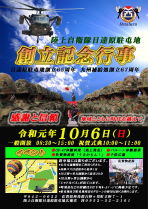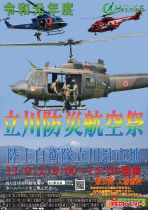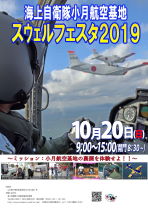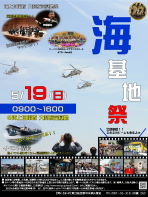Gifu-Kakamigahara Air and Space Museum
The Kakamigahara Aerospace Science Museum has been renovated and rebranded as the Gifu-Kakamigahara Air and Space Museum (see Bulletin Board report for March 24, 2018).
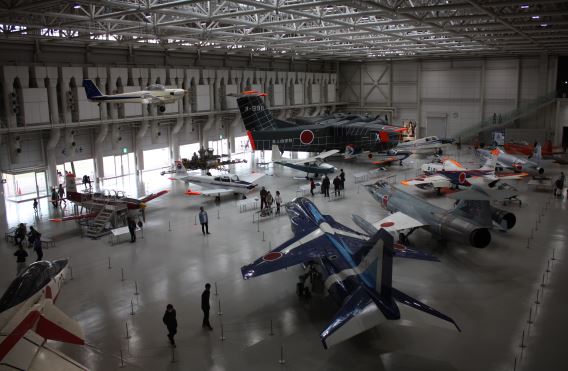 A view of the main exhibition hall from the opposite end to that shown in the Bulletin Board entry for the
A view of the main exhibition hall from the opposite end to that shown in the Bulletin Board entry for the
day of its official opening, March 24, 2018.
Officials from Gifu Prefecture and Kakamigahara City, located around 15 miles (25 km) north of Nagoya, Aichi Prefecture, jointly announced the basic renovation concept on September 1, 2015. At that time, it was envisaged that the existing 6,700 square metres of floor area would be increased by 4,000 square metres, and the exhibition floor space divided into aviation and space zones. As would to be expected, floor space was to be assigned to new or upgraded exhibits that provide “hands-on” experiences, including a flight simulator; a new, high-definition 3D film theatre was also planned. The then price tag of around three billion yen (equivalent to 26.5 million U.S. dollars, at the mid-February 2016 rate of exchange) for the improvements was to be borne jointly both parties, and the new facility jointly owned and operated.
“As a museum that will be representative of Japan, the concept has been considered from an all-Japan initiative that will stand comparison with the Smithsonian National Air and Space Museum in the United States,” emphasized Gifu Governor Hajime Furuta, as quoted in an article that appeared in the Gifu Shimbun the day after the announcement. For his part, Kakamigahara City Mayor Kenji Asano said that he wanted to work on enhancing the visitor experience, such as by offering tours in collaboration with JASDF Gifu AB, thereby making a museum visit a more attractive proposition.
Part of the efforts to enhance the visitor experience has involved making information available in English, not only by written translations* of exhibit descriptions and embedded video subtitling but also via technology that enables visitors to read subtitles direct from their mobile phones. This system was also being designed to enable the provision of subtitles translated into Chinese and Korean.
Visitor numbers to the former museum totaled 488,000 in the first year (1996) and fell by roughly half the following year. Dipping below 150,000 for the first time in 2004, they had always remained above 100,000 and showed an increase to 123,000 in 2013, the last year for which figures were shown in the documentation supporting the new project. The museum remains hampered somewhat by its location, and transport link improvements were bound to have been an area that was looked at very closely.
Serving as the symbol of the Kakamigahara connection with aviation, it was always intended that the sole Kawasaki Ki-61 Hien fighter still extant in Japan would ‘come home’ to a specially designated area, as befits the jewel in the crown, but in the company of several other veterans.
(*) In the interests of full disclosure, it should be pointed out that J-HangarSpace was fortunate enough to be able to provide the initial versions of the English-language translations of most of the aviation exhibit descriptions and for the video subtitling at this museum. Also, a museum of this kind is always a work in progress, and visiting so soon after the official opening, some exhibits and features had yet to be installed or been subjected to unexpected changes (and the same applied to some of the translations).
 The hallowed Hien fighter forms the centerpiece of the new-look museum. The display is intended to
The hallowed Hien fighter forms the centerpiece of the new-look museum. The display is intended to
show the aircraft in the condition it was in when found after the end of the war in 1945; the orange
and red hinomaru on the fuselage and wing are from spotlights. An account of the Hien’s
postwar wanderings and recent restoration appears at the foot of this page.
Getting the Lie of the Land
Whereas Tokorozawa, the site of a well-known museum in Saitama Prefecture, served as the cradle of Japanese aviation, Kakamigahara justifiably lays claim to having been the cradle of the Japanese aviation industry.
As far back as the 1860s, the then barren, erosion-blighted plateau known as Kakamigahara—one of the meanings of the word hara in its name is ‘wilderness’—had served as an area for gunnery practice. During the Meiji Period (1868–1912), the facilities were upgraded to an Army artillery firing range.
World War I having demonstrated the part air power would play in any future conflicts, Kakamigahara again drew the attention of military planners, this time to become the site of Japan’s second and largest Army airfield, completed in 1917. Air and support units soon began to be transferred from the base at Tokorozawa, which had been suffering from a lack of space, and flight training on imported types, including Maurice Farman biplanes, got under way.
In 1920, the arrival of the first railway link and station themselves served as the signals for the infrastructure development that attracted the key player in the area’s growth as an aviation industry hub: Kawasaki Dockyard Co., Ltd. The company was at that time diversifying into the building of aircraft and had enterprisingly acquired the licence to build the Salmson 2A2, the French Air Force’s mainstay reconnaissance aircraft in the latter stages of World War I, at its brand-new Kakamigahara Works, which were completed in 1923. In the meantime, the 2A2’s Salmson Z9 engine, for which Kawasaki had also secured a licence, was produced by the Army at its Tokyo Artillery Arsenal.
 This advertisement for Kawasaki Dockyard lists aircraft and seaplanes among its products and its aircraft
This advertisement for Kawasaki Dockyard lists aircraft and seaplanes among its products and its aircraft
factory in Kobe, so this dates from before 1937, when the company centralized its aircraft production
in Kakamigahara. The Type 88 Reconnaissance Aircraft pictured was presented under the aikoku
(patriotism) programme by which the general public, companies and local organisations made
donations for the purchase of Army aircraft. Aikoku 19 was purchased with funds raised by the
people of Hyogo Prefecture, where Kobe is located, and presented at a ceremony held at a
training ground close to Himeji Castle on April 24, 1932. (Source: Wikimedia Commons)
Kakamigahara went on to become one of the nation’s leading aircraft manufacturing plants and, in common with what became the adjoining Gifu military airfield, was thus subjected to air raids in the latter stages of World War II.
In parallel with the advances made in building up the local aviation industry, over the years there arose a flight test centre on par with similar establishments overseas. The airfield ‘took off’ as a flight test facility from the mid-1920s, when the Mitsubishi company airfield located on the outskirts of Nagoya became too small. Today, the shared airfield is used for test flights conducted by KHI and the JASDF’s Air Development and Test Wing. Naturally, Kawasaki holds the highest proportion of the 75 aircraft types that have made their first flights from here, from the Army Type 2 Model 1 Reconnaissance Aircraft (Salmson 2A2) in 1922 to the prototype XC-2 transport in 2010.
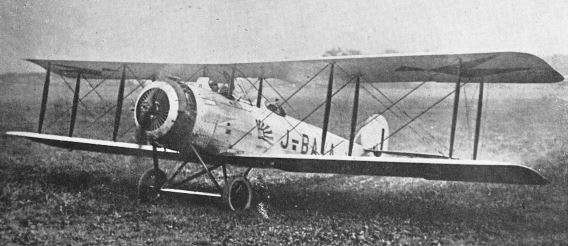 The Army Type 2 Model 1 Reconnaissance Aircraft (Salmson 2A2) was the aircraft type that set Kawasaki
The Army Type 2 Model 1 Reconnaissance Aircraft (Salmson 2A2) was the aircraft type that set Kawasaki
Dockyard on the road to becoming a major player in the Japanese aircraft industry. A total of 300 were
built up to August 1927, and the type proved popular when passed to civil operators, including
The Asahi Shimbun news organization shown here, which operated several in its fleet.
(Photo from Sept. 1953 issue of The World’s Aircraft, used with permission of Hobun Shorin, Co., Ltd.)
The area was well placed for the period of reconstruction that followed the 1952 lifting of the seven-year ban on all aviation activities, imposed during the postwar Allied Occupation. Although the airfield was greatly reduced in size, the factory had grown significantly when Kawasaki Dockyard centralized its aircraft operations there under the name Kawasaki Aircraft Co., Ltd. in 1937. Facilities such as that in the nearby town of at Inaba were switched to the manufacture of bus bodies to stay afloat immediately after the war. Although Kawasaki Dockyard had changed its Japanese name to the equivalent of Kawasaki Heavy Industries, Ltd. in 1939, it was to be 1969 before its English name was changed to Kawasaki Heavy Industries (KHI), following the merger of the land (rolling stock, motorcycles), sea (dockyard) and air business arms. KHI’s Gifu Works remains a major local employer, but the company’s aerospace activities now account for only around 20% of sales.
When four towns in the area, including Inaba, were merged and granted city status, on April 1, 1963, they adopted the name that had originally been given to the plateau. According to the city’s website, its resident population on April 1, 2018, was 148,000.
 Aerial view of Kakamigahara City and Gifu air base, 1987
Aerial view of Kakamigahara City and Gifu air base, 1987
(Photo: Ministry of Land, Infrastructure, Transport and Tourism via Wikimedia Commons)
Museum Beginnings
In an area not so much steeped in but overflowing with Japanese aviation history, it was perhaps only a matter of time (and money) before thoughts would pass to preserving and conveying something of that history.
Spanning the era from the earliest propeller-driven biplanes to the space age, via the advent of jet-powered aircraft during World War II, the avowed aim of the initial project was threefold: to look back at what challenges those involved in Japan’s aerospace efforts had confronted through the city’s aerospace history; to convey aerospace culture to subsequent generations; and to provide a fun learning experience for the younger generation.
The result was the Kakamigahara Aerospace Museum, the first iteration of the facility, which opened on March 23, 1996. (More information on the museum’s previous existence is included later in this report.) To promote interest in science, the facility’s name was changed to the Kakamigahara Aerospace Science Museum and more science-related exhibits and activities incorporated from April 2005.
Wright Flyer/Army Type 2 Model 1 Reconnaissance Aircraft (Salmson 2A2) Replicas
In the post-refurbishment layout, the first exhibit zone the visitor encounters is that containing a full-scale replica Army Type 2 Model 1 Reconnaissance Aircraft and, suspended from the ceiling, a replica Wright Flyer.
Actually built at the Kawasaki Dockyard factory in Kobe, Hyogo Prefecture, the first Army Type 2 Model 1 Reconnaissance Aircraft was taken into the air for the first time from the then village of Sohara, one of the towns that eventually merged to form the city of Kakamigahara.
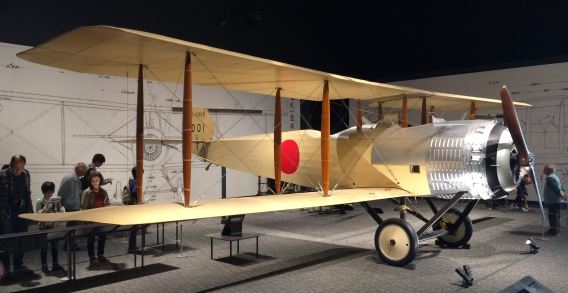 The lovingly reproduced Type 2 Model 1 Reconnaissance Aircraft replica was completed by an
The lovingly reproduced Type 2 Model 1 Reconnaissance Aircraft replica was completed by an
association working in cooperation with Kawasaki Heavy Industries (KHI) in time for the
opening of the museum in 1996. Of great assistance in the project were the famous
Kawasaki aircraft designer Takeo Doi (1904–1996), who at that time was still
acting as a technical advisor to KHI, and a Salmson manual published in 1931.
To a pleasant solo violin sound track, a video screened along one wall initially provides a visual doffing of the cap to some of the pioneers who had held ‘lofty aspirations’ even long before the Wright Brothers. After performing a touch-and-go on achievements elsewhere in the world, the narrative then charts the early days of aviation in Japan and how the domestic aviation industry got its start in Kakamigahara.

Also on display (above), courtesy the National Museum of Nature and Science in Tokyo, is the engine (manufactured by the Tokyo Artillery Arsenal in December 1920) and forward fuselage section of a real Army Type 2 Model 1 Reconnaissance Aircraft. At the time of J-HangarSpace’s visit the main descriptions for these items were, unlike many others, in Japanese only. Basically, that for the engine states that the adoption of the Salmson had stemmed from the type’s use by a 61-man French Aviation Mission that had visited Japan at the Army’s behest in 1918. In the space of six months, the mission offered instruction and guidance on the piloting, operation and manufacture of aircraft as well as on engine maintenance. The description for the forward fuselage section states that the relic also served as an important reference in the building of the replica.
 Placed next to the Salmson replica is its Heritage of Industrial Modernization certificate signed
Placed next to the Salmson replica is its Heritage of Industrial Modernization certificate signed
by the then Minister of Economy, Trade and Industry Toshihiro Nikai in February 2009. In the
background can be seen a still from a very effective CG video sequence depicting an Army
Type 2 Model 1 Reconnaissance Aircraft flying over modern-day Kakamigahara.
Hien Exhibit / Prewar and Wartime Aircraft Development
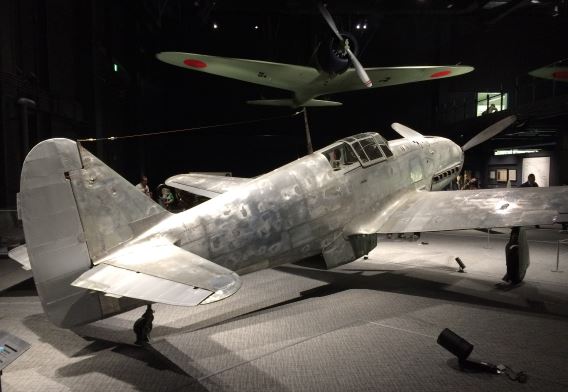
The visitor is then guided toward the suitably low-lit inner sanctum that is the room containing the Hien fighter, the history and restoration of which are described later on this page. Suspended from the ceiling is another full-scale replica, this time of the 12-Shi Carrier-Borne Fighter prototype that, to use modern-day parlance, served as the technology demonstrator for the A6M1 Zero.
The Hien will rightly be the star attraction for many visitors. The Japanese on the display panel that has only its title—Basis and Reason for Restoration of Hien No. 6117—in English is an extract from an article in the spring 2017 issue of the Japan Aeronautic Association magazine Air Forum, a translation of which is included below.
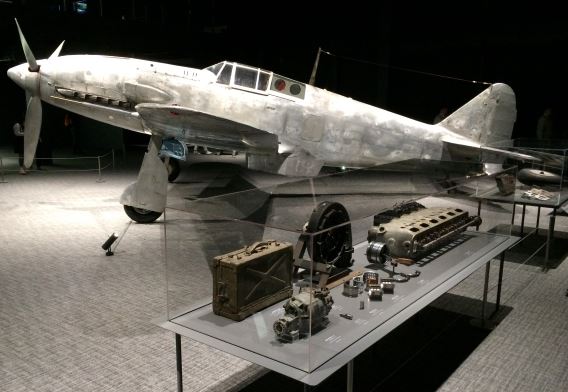
As befits the almost religious ambience, several related relics have been gathered together for placement on display (above). In this view, these include the following:
Rear table: Main wheel and tail wheel; instrument panel sections
Front table: Field toolbox for the Ha-40 engine fitted to early-model Hien fighters; Ha-40 supercharger and fuel pump; Ha-40 engine components; Ha-40 cylinder block and camshaft

An example of the later Ki-61-IIKai Hien’s Ha-140 engine is mounted on a cradle (above) close to a replica of its supercharger and, on loan from the Smithsonian Air and Space Museum in Washington, DC, an Ha-42-21Ru. Intended for the Kawasaki Ki-91 Long-Range Heavy Bomber project, the latter was itself a development of the Ha-140 that also powered the twin-engine Type 4 Hiryū Heavy Bomber (Ki-67, Peggy), one of the no less than 28 Mitsubishi-designed aircraft that completed their maiden flights from Kakamigahara.
Four multifunctional exhibit description panels cover the Hien and the 12-Shi Carrier-Borne Fighter as well as their respective chief designers, Takeo Doi and Jirō Horikoshi, and incorporate images of the airframe production lines. In between them are three standard showcases containing, by way of example:
- A diary that Doi kept during a visit to Europe in 1931–1932
- An engine handling manual for the Kawasaki Type 4 Assault Aircraft (Ki-102a, Randy) submitted to the Allied Occupation forces
- A letter from Horikoshi to Doi, sent on December 12, 1953, the year after aviation activities had resumed, following a seven-year postwar hiatus (of which more later)

Other Hien-related exhibits include a replica Hien Model 1b instrument panel (above); panels for a Zero Model 52a and a Ki-43-1 Hayabusa are also on display.
A nearby showcase houses a 200-litre (53 U.S. gallon) Model 2 wooden drop tank that is tied in with a video of a wartime propaganda film showing drop tank production in a factory at the then Takayama High School for Girls, Gifu Prefecture, in 1944.
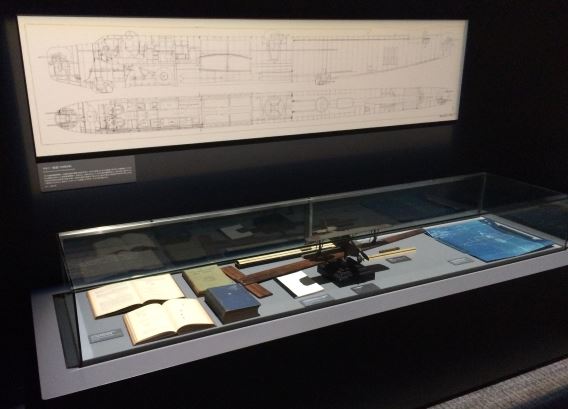
Placed against the far wall is a showcase of more Doi memorabilia (above), including some of the tools of his trade and a Kawasaki KDA-5 (Army Type 92 Fighter) manual, with a replica general arrangement drawing of the Ki-91 mounted on the wall behind. There is even a German book on aerodynamics that is labelled as having belonged to Doi during his student days.
A display case of typical clothing worn by pilots and maintenance crew members from the mid-1930s is flanked, on one side, by another containing items such as an Army Type 1 Parachute from 1944 and, on the other, by a draughtsman’s table, complete with implements, and a propeller blade from a Ki-102 (Randy).
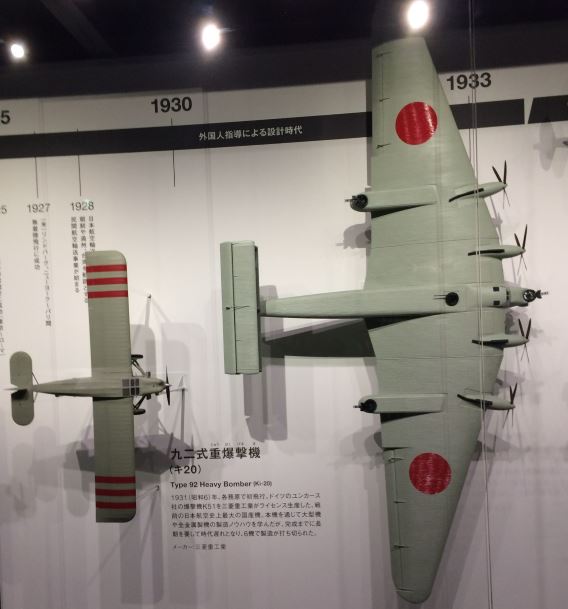
Opposite the Hien, an illuminated wall display uses large-scale models (the section shown above includes the impressive Type 92 Heavy Bomber [Ki-20]) to chart the development of the Japanese aviation industry prior to and during World War II. The timeline is divided into five periods: research and study period (imports, trial manufacture); licence production (acquisition of manufacturing technologies); design under guidance of foreign designers; trying to keep up with advanced aviation nations; and the period in which the global level is attained. As the parallel major events appear in Japanese only, these can be summarized in English as follows:
| 1903 | Wright Brothers’ first flight success |
| 1910 | First flights of powered heavier-than-air aircraft in Japan |
| 1911 | First flight of Japanese-built aircraft (Narahara 2) Army airfield at Tokorozawa, Saitama Prefecture, inaugurated |
| 1917 | Army airfield at Kakamigahara inaugurated (Becomes base for 2nd Air Battalion in 1918) |
| 1918 | Japanese companies (Nakajima, Mitsubishi, Kawasaki, Kawanishi, Aichi Watch) embark on aircraft manufacturing |
| 1919 | French Aviation Mission arrives and provides tuition and guidance at various locations, including Kakamigahara |
| 1920 | 1st Air Battalion based at Kakamigahara |
| 1921 | British Sempill Mission comes to Japan |
| 1922 | First flight of Kawasaki Dockyard-built Salmson 2A2 at Kakamigahara |
| 1925 | First Japan-Europe flight (Tokyo to Rome, in two Asahi Shimbun Breguet 19s) |
| 1927 | Charles Lindbergh completes first solo non-stop flight from New York to Paris |
| 1928 | Japan’s Ministry of Communications establishes air transport services to Korea, Taiwan; civil aviation companies commence operations |
| 1937 | Asahi Shimbun’s Kamikaze (Mitsubishi Karigane Communications Aircraft [Ki-15]) flown from Tokyo to London |
| 1938 | Koken long-range research aircraft sets closed-circuit world record |
| 1939 | Mainichi Shimbun’s Nippon (Mitsubishi Twin-Engine Transport) flown around world First flight of a jet aircraft (Heinkel He178) in Germany |
| 1942 | Sikorsky flies world’s first mass-produced helicopter |
| 1943 | Kawasaki Ken-3 Experimental Aircraft (Ki-78) sets Japanese airspeed record on flight from Kakamigahara |
| 1945 | World War II ends, Japan banned from all aviation activities (until 1952) |
Suspended from the ceiling here is another full-scale replica, this time of a Grade II Libelle monoplane, the type that Army Capt. Kumazō Hino used to make the first powered flight by a heavier-than-air aircraft in Japan on December 19, 1910.
 Many of the exhibit description panels combine straight text, images and touch-screen functions to great
Many of the exhibit description panels combine straight text, images and touch-screen functions to great
effect. That nearest the camera here provides information on the life and work of Kawasaki aircraft
designer Takeo Doi, who lived to see the opening of the original Kakamigahara museum only to
pass away nine months later, aged 92, in December 1996.
Located to one side of the main exhibits is a large relief map of the Kakamigahara area, onto which are projected facts about the development of the city, which is inextricably linked with the development of Japan’s aviation industry.
First Flight Wall
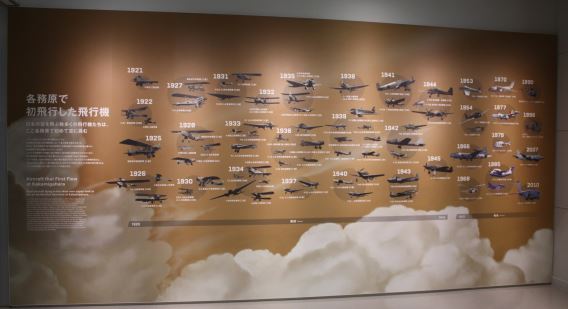
In the passageway that connects the Hien exhibit with the main hall is a wall display (above) depicting the 75 aircraft that have made their first flights from Kakamigahara. Although some are well-known, the aircraft types are not given in English, so they are listed in three parts below. As Kawasaki accounted for no less than 39 of those 75 aircraft, photos of some of the company’s lesser-known types are also included.
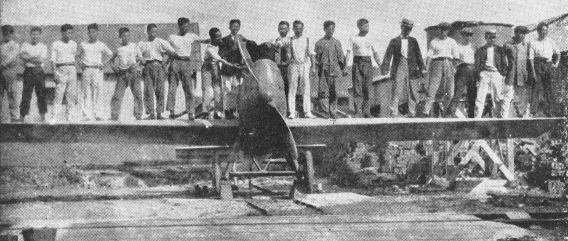 Company employees delight in demonstrating the strength of the cantilever wing fitted to the Kawanishi
Company employees delight in demonstrating the strength of the cantilever wing fitted to the Kawanishi
K-2 high-speed racer. In the absence of a full Kawasaki presence, in July 1921 this diminutive aircraft
became the first to make its maiden flight from Kakamigahara; literally a small beginning.
(Photo from June 1953 issue of The World’s Aircraft, used with permission of Hobun Shorin, Co., Ltd.)
 The second Kawasaki type to make its maiden flight from Kakamigahara airfield, on February 19, 1926,
The second Kawasaki type to make its maiden flight from Kakamigahara airfield, on February 19, 1926,
was the Type 87 Heavy Bomber. Although this rugged, licence-built Dornier Do. N design looked like a
seaplane, the aircraft was actually intended for land-based operations. Its lacklustre performance
prompted the nickname dongame, or slow turtle, the don having the double meaning of ‘Do. N’.
(Photo from Sept.1953 issue of The World’s Aircraft, used with permission of Hobun Shorin, Co., Ltd.)
 Kawasaki Type 88 Model 1 reconnaissance aircraft at Yokaichi airfield, Shiga Prefecture, in June 1935.
Kawasaki Type 88 Model 1 reconnaissance aircraft at Yokaichi airfield, Shiga Prefecture, in June 1935.
The KDA-2 prototype was the first designed by Kawasaki, albeit on the basis of work carried out by the
company’s German collaborator, Dr. Richard Vogt (1894–1979) at the University of Göttingen.
Following an evaluation, the KDA-2 beat off competition from three other companies for the
award of a contract and 200,000 yen in prize money. (Photo via Wikimedia Commons)
Roll Call of First Flights from Kakamigahara
Part 1 (1921–1936)
(Dates given, where known. Aircraft in bold type are those that appear in the accompanying photos; with the exception of the Kawanishi K-2, all were produced by Kawasaki.)
| 1921 | July | Kawanishi K-2 High-Speed Racer |
| 1922 | Nov. 9 | Army Type 2 Model 1 Reconnaissance Aircraft (Salmson 2A2) |
| Kawanishi K-3 Communications Aircraft | ||
| 1925 | December | Mitsubishi Washi (Eagle, company designation 2MB2) Experimental Light Bomber |
| 1926 | Feb. 19 | Kawasaki Type 87 (Dornier N) Heavy Bomber |
| Prototype Mitsubishi Tora (Tiger, 2MT5) Carrier-Borne Attack Aircraft | ||
| Mitsubishi Type 87 (2MB1) Light Bomber | ||
| 1927 | circa Feb. | Kawasaki Type 88 Model 1 Reconnaissance Aircraft |
| c. July | Mitsubishi Tobi (Kite, 2MR1) Experimental Reconnaissance Aircraft | |
| 1928 | March | Kawasaki KDA-3 Experimental Fighter |
| May | Mitsubishi Hayabusa (Peregrine Falcon, 1MF2) Experimental Fighter | |
| May 28 | Kawanishi K-12 Sakura-go (Cherry Blossom) Long-Range Aircraft | |
| Kawasaki KDC-2 Transport Aircraft (modified Type 88 Model 2 Reconnaissance Aircraft) |
||
| 1930 | Kawasaki KDA-5 Fighter (Type 92 Fighter) | |
| Mitsubishi Navy Type 90 (K3M1) Land-Based Trainer Aircraft | ||
| 1931 | Mar. 28 | Mitsubishi Type 92 (2MR8) Reconnaissance Aircraft |
| c. October | Kawasaki KDA-6 Experimental Reconnaissance Aircraft (A-6 High-Speed Communications Aircraft) |
|
| Oct. 26 | Mitsubishi Type 92/Ki-20 Heavy Bomber (Note: Some sources give Dec. 26 as first flight date) |
|
| 1932 | Oct. 19 | Mitsubishi Navy 7-Shi Twin-Engine Carrier-Borne Attack Aircraft (Type 93 Land-Based Attack Aircraft) |
| 1933 | March | Mitsubishi 7-Shi Carrier-Borne Fighter |
| c. March | Mitsubishi Type 93 Heavy Bomber (Ki-1) | |
| c. April | Kawasaki Type 93 Light Bomber (Ki-3) | |
| c. May | Mitsubishi Type 93 Twin-Engine Light Bomber (Ki-2) | |
| 1934 | January | Mitsubishi 8-Shi Carrier-Borne Two-Seat Fighter |
| February | Kawasaki Ki-5 Experimental Fighter | |
| April | Mitsubishi Navy 8-Shi Special Reconnaissance Aircraft | |
| c. August | Mitsubishi 9-Shi Carrier-Borne Attack Aircraft | |
| Kawasaki C-2 High-Speed Communications Aircraft | ||
| 1935 | Feb. 4 | Mitsubishi Navy 9-Shi Single-Seat Fighter (Type 96 Carrier-Borne Fighter) |
| March | Kawasaki Type 95 Fighter (Ki-10) | |
| July | Mitsubishi Navy 9-Shi Land-Based Medium Attack Aircraft (Type 96 Land-Based Attack Aircraft, G3M Nell) |
|
| 1936 | May | Mitsubishi Type 97 Command Reconnaissance Aircraft (Ki-15, Babs) |
| c. June | Landplane version of Aichi 10-Shi Observation Seaplane | |
| c. August | Mitsubishi Ki-33 Experimental Fighter | |
| November | Mitsubishi 10-Shi Carrier-Borne Attack Aircraft (Type 98-2 Carrier-Borne Attack Aircraft, B5M Mabel) |
|
| c. November | Kawasaki Ki-28 Experimental Fighter | |
| Dec. 18 | Mitsubishi Type 97 Heavy Bomber (Ki-21, Sally) |
 Proudly wearing the kanji for aikoku (patriotism), Kawasaki Type 92 Fighter Aikoku 20 was donated by
Proudly wearing the kanji for aikoku (patriotism), Kawasaki Type 92 Fighter Aikoku 20 was donated by
the ‘government and people of Korea’, which was ruled by Japan following its annexation in 1910 until
1945. The presentation ceremony was held at Yeouido airfield in what was then known to the
Japanese as Keijo—now South Korea’s capital, Seoul—on May 15, 1932.
(Photo from Sept. 1953 issue of The World’s Aircraft, used with permission of Hobun Shorin, Co., Ltd.)
 The sole Kawasaki A-6 High-Speed Communications Aircraft (J-BBFA, Asahi Shimbun fleet No. 111) was
The sole Kawasaki A-6 High-Speed Communications Aircraft (J-BBFA, Asahi Shimbun fleet No. 111) was
first flown in 1931 as the ultimately unsuccessful single-seat Kawasaki KDA-6 Experimental
Reconnaissance Aircraft before conversion to a two-seater.
(Photo from Sept. 1953 issue of The World’s Aircraft, used with permission of Hobun Shorin, Co., Ltd.)
 The Ki-28 Experimental Fighter was Kawasaki’s entry in the competition that produced the slower but
The Ki-28 Experimental Fighter was Kawasaki’s entry in the competition that produced the slower but
more manoeuvrable Nakajima Ki-27, which was powered by the same Ha-9 engine. The photo shows
the second of the two aircraft of this type built. Despite its failure, the Ki-28 proved a useful step
on the way to the Ki-61 Hien. (Photo via Wikimedia Commons)
Roll Call of First Flights from Kakamigahara
Part 2 (1937–1945)
(Dates given, where known. Bold type indicates those Kawasaki aircraft that appear in the accompanying photos.)
| 1937 | Feb. 26 | Mitsubishi Type 97 Light Bomber (Ki-30, Ann) |
| March | Kawasaki Type 98 Light Bomber (Ki-32, Mary) | |
| 1938 | Jan. 6 | Aichi 11-Shi Carrier-Borne Bomber (Type 99 Carrier-Borne Bomber, D3A Val) |
|
1939 |
January | Kawasaki Experimental Twin-Engine Two-Seat Fighter (forerunner of Ki-45, Nick) |
| Apr. 1 | Mitsubishi 12-Shi Carrier-Borne Fighter (Type Zero Carrier-Borne Fighter, Zeke) |
|
| Apr. 25 |
Terada (Nippon Kokusai) TK-3 Passenger Transport |
|
| May | Kawasaki Type 99 Twin-Engine Light Bomber (Ki-48, Lily) | |
| June | Mitsubishi Type 99 Assault Aircraft (Ki-51, Sonia) | |
| Oct. 23 | Mitsubishi 12-Shi Navy Land-Based Attack Aircraft (Type 1 Land-Based Attack Aircraft, G4M Betty) |
|
| November | Mitsubishi Type 100 Command Reconnaissance Aircraft (Ki-46, Dinah) | |
|
1940 |
Kawasaki Type 1 Freight Transport (Ki-56, Thalia) | |
| August | Mitsubishi Type 100 Transport (Ki-57, Topsy) | |
| Kawasaki Ki-60 Experimental Fighter* | ||
| 1941 | c. September | Kawasaki Ki-45Kai Twin-Engine Two-Seat Fighter (Nick) |
| December | Kawasaki Army Type 3 Hien Fighter (Ki-61, Tony) | |
|
1942 |
c. November | Kawasaki Ki-66 Experimental Dive Bomber |
| Dec. 26 | Kawasaki Ken-3 Experimental High-Speed Research Aircraft (Ki-78) | |
| Dec. 27 | Mitsubishi Type 4 Hiryū Heavy Bomber (Ki-67, Peggy) | |
| 1943 | September | Kawasaki Ki-96 Experimental Twin-Engine Heavy Fighter |
| December | Kawasaki Ki-64 Experimental High-Speed Fighter | |
|
1944 |
March | Kawasaki Type 4 Assault Aircraft (Ki-102, Randy) |
| September | Kawasaki Ki-108 Experimental High-Altitude Fighter | |
| Nov. 18 | Mitsubishi Ki-83 Experimental Long-Range Fighter | |
| 1945 | Feb. 1 | Kawasaki Type 5 Fighter (Ki-100) |
(*) Although listed in 1940 by the museum, sources seem to agree that the first of the three Ki-60s was not completed until March 1941.
 Derived from the Lockheed Model 14 Super Electra, which Kawasaki had built under licence, the
Derived from the Lockheed Model 14 Super Electra, which Kawasaki had built under licence, the
military use-enhanced Ki-56 remained in production from 1940 to 1943. A total of 121 of the
type were completed during that time.
(Photo from Sept. 1953 issue of The World’s Aircraft, used with permission of Hobun Shorin, Co., Ltd.)
 Standing out against a hangar and gleaming in some post-shower sunshine is one of the six Ki-66
Standing out against a hangar and gleaming in some post-shower sunshine is one of the six Ki-66
experimental dive bombers built for the close air support role. Completed in a seven-month
period from October 1942, the project was brought to a halt in October 1943.
(Photo from Sept. 1953 issue of The World’s Aircraft, used with permission of Hobun Shorin, Co., Ltd.)
 Dating back to 1938 and peaceful civilian efforts geared toward the breaking of speed records, the Ken-3
Dating back to 1938 and peaceful civilian efforts geared toward the breaking of speed records, the Ken-3
(Kensan [Research] 3) project was a natural target for the military, who assigned Kawasaki the task of
building the aircraft. Despite the high-tech innovations incorporated into its design, performance
was disappointing, and the programme was terminated after 32 test flights in January 1944.
Not as fortunate as the museum’s Hien, the sole example was among the aircraft
crushed by U.S. forces at Gifu airfield in 1945.
(Photo from Sept. 1953 issue of The World’s Aircraft, used with permission of Hobun Shorin, Co., Ltd.)
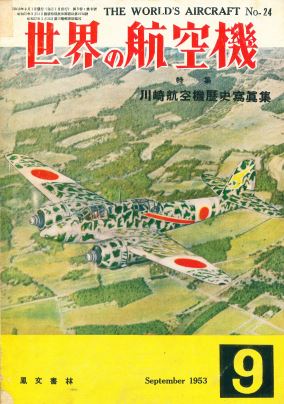 Likely based on a photo taken by the wartime IJAAF photographer Shinkuchi Kikuchi (1916–1990), the
Likely based on a photo taken by the wartime IJAAF photographer Shinkuchi Kikuchi (1916–1990), the
colourized image gracing the cover of the September 1953 issue of Sekai no Kōkūki (The World’s
Aircraft) depicts a 3rd Hikōtai, 53rd Sentai Ki-45KAIc (Nick) airborne over pine forests on the
Boso Peninsula, Chiba Prefecture, in early March 1945. Then based at Matsudo,
the aircraft was the mount of Capt. Toshio Sassa.
J-HangarSpace would like to thank Hobun Shorin, Co., Ltd. for granting permission to reproduce some of the photographs from this magazine.
(The summer 2009 issue of Arawasi International contained restored images from Kikuchi’s visits to the 53rd Sentai, images that had appeared in their original condition in the March 1995 issue of Kōkū Fan.)
Roll Call of First Flights from Gifu/Kakamigahara
Part 3 (from 1953)
(Dates given, where known. Bold type indicates those aircraft that appear in the accompanying photos.)
| 1953 | July 21 | Kawasaki KAL-1 (museum exhibit) |
| 1954 | Feb. 11 | Kawasaki KAT-1 (museum exhibit) |
| Nov. 25 | Kawasaki KAL-2 | |
| 1966 | July 21 | Kawasaki P2V-7Kai Neptune (P-2J Turbo-Neptune) |
| 1968 | Kawasaki KHR-1 rigid-rotor helicopter | |
| 1970 | Nov. 12 | Kawasaki XC-1 |
| 1977 | Dec. 23 | Kawasaki P2V-7 Variable Stability Aircraft (VSA) |
| 1979 | Aug. 10 | Kawasaki BK117 |
| 1985 | July 29 | Kawasaki XT-4 |
| Oct. 28 | National Aerospace Laboratory (NAL) Asuka STOL research aircraft (museum exhibit) |
|
| 1990 | Kawasaki-Hughes OH-6J used to test new rotor system (museum exhibit) |
|
| 1996 | Aug. 6 | Kawasaki XOH-1 (museum exhibit [wooden mockup]) |
| 2007 | Sept. 28 | Kawasaki XP-1 |
| 2010 | Jan. 26 | Kawasaki XC-2 |
 Having lost out to the Fuji LM-1/KM-2 for SDF orders, the first of the two KAL-2 prototypes was handed
Having lost out to the Fuji LM-1/KM-2 for SDF orders, the first of the two KAL-2 prototypes was handed
over to the JMSDF on December 17, 1955. Having been operated in the liaison role from Tateyama
(twice) and Kanoya (as pictured), the aircraft was withdrawn from use at Tokushima on
April 20, 1966, and placed on display at the base; its ultimate fate is unknown.
(Photo: JMSDF via Wikimedia Commons)
 The P2V-7 VSA fly-by-wire technology demonstrator is towed from the static display area at Iwakuni
The P2V-7 VSA fly-by-wire technology demonstrator is towed from the static display area at Iwakuni
in May 1979, during its time with the 51st Fleet Air Squadron. (Photo: Takao Kadokami)
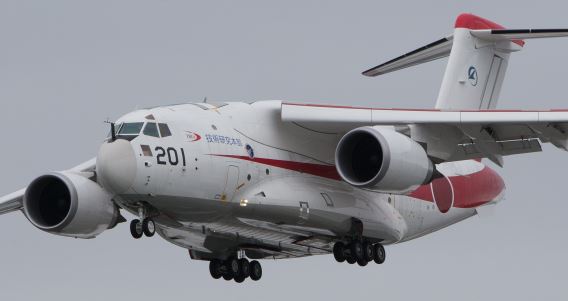 The 75th and most recent maiden flight conducted from what was Kakamigahara airfield was that of the
The 75th and most recent maiden flight conducted from what was Kakamigahara airfield was that of the
Kawasaki XC-2 in January 2010, nearly 90 years after the Kawanishi K-2.
(Photo: Andy Binks [Oct. 2014])
Main Exhibition Hall / Postwar Aircraft Development
In contrast to the tenebrous hall containing the Hien, on sunny days the cavernous main exhibition hall almost requires the donning of sunglasses. Here the theme is Postwar Aircraft Development.
Lined up along the left wall as you enter and listed from the front to the back of the hall, are the following aircraft.
 Kawasaki KAT-1 (On display since April 19, 2003)
Kawasaki KAT-1 (On display since April 19, 2003)
The KAT-1 was the then Kawasaki Aircraft Co., Ltd.’s attempt to have one of its designs adopted as the primary training aircraft for the National Safety Agency (today’s Ministry of Defense) in 1954. Having lost out to the T-34A Mentor, JA3084 was used as a training aircraft at a Ministry of Transport flight academy in Miyazaki Prefecture from February 1954 to October 1962. That same month, the aircraft was transported to the opposite end of the country and placed on display at a children’s science education facility in Takikawa, Hokkaido. There the aircraft remained until transferred home to Kakamigahara in 2002 and made ready for display after an absence of some 49 years.
 Lockheed T-33A (Arrived July 14, 1998)
Lockheed T-33A (Arrived July 14, 1998)
Delivered to the JASDF in November 1956, this Kawasaki-assembled aircraft provided 27 years of active test flight service at Gifu AB, from 1967 to 1994. Having been officially struck off charge in March 1997, on July 14, 1998, the now long-term Kakamigahara resident was ignominiously ‘flown’ the short distance to the museum dangling from a Kawasaki Helicopter System KV-107 and placed on display the following day.
 Fuji T-1B (Arrived on loan Jan. 16, 2007)
Fuji T-1B (Arrived on loan Jan. 16, 2007)
The T-1 was the first indigenously produced jet aircraft to see operational service in Japan. Although the museum has held the prototype T-1 in store since late April 2002, the 10th aircraft was chosen for display due to its long association with Gifu AB, which started when the aircraft was still a factory-fresh T1F2 in 1960 and ended with its final flight on March 2, 2006. Retaining the markings applied to commemorate the 50th anniversary of Air Proving Wing (APW, now the Air Development & Test Wing) in 2005, the aircraft was—unlike the T-33A—towed intact to its new home. A YouTube video exists (link) of the aircraft being moved out again prior to the start of renovation work in October 2016.
(Below, right) Mitsubishi-Lockheed F-104J Starfighter (Exhibited since March 1996 opening)
Initially delivered to the 201st Sqn in February 1963, this aircraft also flew with the 83rd Air Wing at Naha before its final, year-long active assignment with the APW at Gifu, from 1985 to April 1986.

(Above, left) Mitsubishi T-2 (Placed on display around October 2001)
Still bearing the markings from its time with the Blue Impulse aerobatic team, this aircraft’s active service career began in 1981 and ended in 1995.
 Mitsubishi T-2 Control-Configured Vehicle (CCV)
Mitsubishi T-2 Control-Configured Vehicle (CCV)
(Arrived for loan display Dec. 2, 2014)
First delivered on July 6, 1972, the third prototype T-2 trainer was naturally initially assigned to the type’s test programme from Gifu AB and then, from April 6, 1982, to the JASDF Air Proving Wing (APW). Converted to investigate flight stability achieved by computer control, the data from which would later be utilized in the development of the Mitsubishi F-2, the single-seat T-2 CCV was first flown from Nagoya on August 9, 1983, and again, this time with a fly-by-wire system installed and its distinctive canard wings fitted, on February 16, 1984.
At the end of the two-year joint TRDI*-APW programme, during which 137 flights were completed, the aircraft was utilized for additional research and test pilot training at Gifu, where it remained in store for airing on base open days following its withdrawal from use on October 31, 2002. Reportedly a target for the museum from the start, arranging the loan of an aircraft that is certified for preservation by the JASDF took time and patience on the part of the Kakagamihara City authorities, but those efforts were eventually rewarded.
(*) The Technical Research and Development Institute of the then Japan Defense Agency, now the Acquisition, Technology and Logistics Agency under the Ministry of Defense
NAL Asuka STOL Research Aircraft (Exhibited since March 1996 opening)
Currently positioned behind the T-2 CCV, the Asuka experimental aircraft dominates the rear of the hall. Developed as a national project by the then Science and Technology Agency’s National Aerospace Laboratory (NAL, now the Japan Aerospace Exploration Agency), the aircraft was designed to investigate short takeoff and landing technologies, in combination with the utilization of a computer-controlled flight system, and ways to reduce aircraft noise footprints. Unlike the other test aircraft in the collection, Asuka was from the outset modelled on rather than a conversion of an existing airframe, in this case a Kawasaki C-1. The two-kanji name Asuka (飛鳥), literally means ‘flying bird’ or ‘bird on the wing’; more obscurely, it was also the name of the Imperial capital during the Asuka period (538–710) in Japanese history.

The above photo shows the configuration of the four entirely new, Japan-produced FJR710 turbofan engines that were mounted ahead of and above the main wing. The STOL performance tests centered on lift generation by means of upper surface blowing (USB), by which the jet efflux from the engines was passed over the top of the blast-protected main wing through double rows of vortex generators and redirected downwards over the flaps. This configuration had already been adopted on twin-engine designs in the mid-1970s, most notably the two Boeing YC-14 tactical transport prototypes as well as the somewhat more successful Antonov An-72. In the case of the Asuka, the test programme lasted for three and a half years, ending on March 30, 1989, with the retirement of the aircraft after 97 flights and 167 flight hours.
On the window side of the hall, again from nearest the entrance, are:
 Kawasaki KAL-1 (Displayed since Dec. 2, 2014)
Kawasaki KAL-1 (Displayed since Dec. 2, 2014)
In 1953, the KAL-1 prototype became the first aircraft designed and manufactured in postwar Kakamigahara. The following year, the displayed KAL-1—the second of the two built—became the first Japanese-produced aircraft to be flown outside Japan on an overseas visit since the end of the war. Having been used by its manufacturer as a corporate aircraft until July 1965, the aircraft was a long-term resident at the Modern Transportation Museum in Osaka from 1966. When, after more than 50 years, that facility closed its doors in March 2014, the necessary moves were made to ensure that the KAL-1 would eventually join its KAT-1 stablemate at their birthplace.
 X1G1B High-Lift Research Aircraft (Exhibited since March 1996 opening)
X1G1B High-Lift Research Aircraft (Exhibited since March 1996 opening)
For more details of this modified Saab 91B Safir, which is certified as an Important Aviation Heritage Asset, please see the feature on the Japan Aeronautic Association Aviation Heritage Archive at the top of the Aviation History page of this website.
 UF-XS Experimental Flying Boat (Exhibited since March 1996 opening)
UF-XS Experimental Flying Boat (Exhibited since March 1996 opening)
For more details of this heavily modified Grumman UF-1 Albatross, which is certified as an Important Aviation Heritage Asset, please see the feature on the Japan Aeronautic Association Aviation Heritage Archive on the Aviation History page of this website.
 NAL Experimental VTOL Flying Testbed (Exhibited since March 1996 opening)
NAL Experimental VTOL Flying Testbed (Exhibited since March 1996 opening)
Reminiscent of 1950s-vintage Rolls-Royce Thrust Measuring Rig, which was also known as the “Flying Bedstead,” this testbed is notable for being the only experimental vertical takeoff and landing (VTOL) aircraft ever developed in Japan. A VTOL test was successfully completed for the first time in Kakuda, Miyagi Prefecture, on December 15, 1970. A programme of experiments that including hovering and multi-directional manoeuvering was brought to an end in the summer of the following year.
 Fuji T-3 (On loan, displayed since Oct. 1, 2008)
Fuji T-3 (On loan, displayed since Oct. 1, 2008)
Currently positioned next to two civilian aircraft that have been present since the start—the Nihon University/Itochu N-62 Eaglet and a Fuji FA-200 AeroSubaru modified for STOL experiments—is an ex-JASDF T-3 primary trainer. The prototype of the design, which was based on the then still in service T-34 Mentor, flew for the first time at Utsunomiya Airfield, Tochigi Prefecture, on September 26, 1974. A total of 50 had been built by the time production ended in 1982.
The late-model example on display was first delivered to the 11th Flying Training Wing on November 28, 1981. After having served with the Gifu-based test unit from 2005 to 2007, ‘547’ was briefly placed in store at the base by the JASDF before arriving on loan at the museum on July 26, 2008. The aircraft is used three times a day for hour-long sessions during which time visitors have the chance to have their photo taken while seated in the cockpit.

Tucked away in the far, right-hand corner is a collection of helicopters (above). The red BK117P-5, which was placed on display on April 20, 2001, is the third prototype of this German-Japanese design. The first used for flight testing in Japan, the aircraft was utilized for the research and development of the helicopter’s automatic control technologies. The other helicopters on display are as follows.
 Kawasaki-Bell 47G3B-KH4 (Exhibited since March 1996 opening)
Kawasaki-Bell 47G3B-KH4 (Exhibited since March 1996 opening)
In 1962, what was then Kawasaki Aircraft (now Kawasaki Heavy Industries) completed a total redesign of a Bell 47G3B, including the addition of a fourth seat in an enlarged cabin, with the aim of improving its versatility. The experience gained laid the foundation for Kawasaki’s own helicopter developments.
The displayed example of what became more simply known as the KH-4 was first delivered to the Japan Coast Guard in December 1971 and passed on to the first of a total of six private owners in January 1982. The aircraft’s registration was cancelled in May 1992, four years before making its debut at the then newly opened Kakamigahara Aerospace Museum.
Masked by the KH-4 is the Kawasaki KHR-1 experimental rigid-rotor helicopter, which was based on a KH-4 and dates from the late 1960s.
 The Kawasaki-Hughes OH-6J used to test a bearingless rotor system
The Kawasaki-Hughes OH-6J used to test a bearingless rotor system
(Displayed since June 6, 2004)
This may look like a scale model, but this is the full-size helicopter that was used to test a bearingless rotor system newly developed by the Japan Defense Agency (now Ministry of Defense) and Kawasaki. Delivered to the JGSDF as a standard OH-6J on February 15, 1974, the aircraft was flown with the new system for the first time on May 10, 1990, and participated in the test programme at Gifu that lasted until 1992. The data gathered was utilized in the design of the rotor head of the Kawasaki OH-1 observation helicopter.
 Kawasaki XOH-1 Mockup (Exhibited since March 1996 opening)
Kawasaki XOH-1 Mockup (Exhibited since March 1996 opening)
This full-scale wooden mockup was produced to assist in the building of the prototype OH-1, which was under development at Kawasaki from 1992.
Another helicopter, an ex-JGSDF OH-6J that was on active service from February 1975 to September 1994, and has also been on display since Day 1 in 1996. This forms an integral part of the exhibit where visitors can gain hands-on experience of a rotorcraft’s controls (see JGSDF Where Are They Now? page).
Examples of Other Exhibits
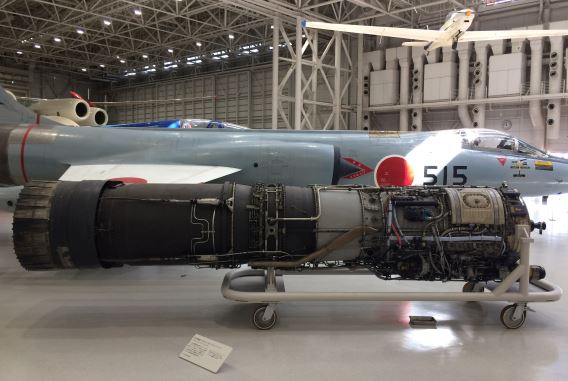
A number of engines are on display in the Aircraft Systems and Mechanics zone next to the film theatre. In addition to the always impressive J79 (with drip tray, above) from an F-104J, these include a Bristol Siddeley Orpheus Mk. 805 (below) from a T-1A—first displayed on March 28, 2007, having previously been used for instructional purposes at the 13th Flying Training Wing at Ashiya—and an XF3 from a T-4.

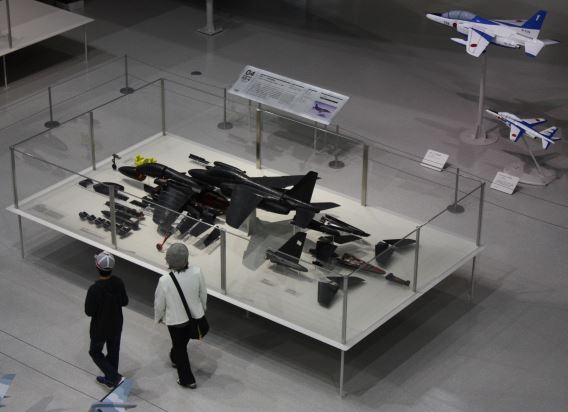
Staying with the T-4, a showcase in the centre of the aisle, next to the Asuka, contains the wind tunnel test scale models (above) that were used in the development of the XT-4 (the T-4 prototype) in the first half of the 1980s. The ‘kit’ includes the three tail variations that were evaluated, a range of drop tank tailfin design options and Lego-like pilot figures. Surprisingly, there is a model of the pod that has been carried by T-4s launched to take dust samples following a North Korean underground nuclear test.
Although outside the scope of J-HangarSpace, mention should be made of the large four-zone area on the upper floor devoted to space exploration. This area also offers great opportunities for shots looking down on the exhibits.
Time for some fresh air.
Aircraft Displayed Outside
All the aircraft on display outside were present when the museum first opened in March 1996. (Note that the Air Nippon YS-11 falls outside the scope of this website.)
In this section, J-HangarSpace offers a “then and now” comparison with the three aircraft as they appeared in October 2000, in the days of film photography. An absentee from that time is an Aérospatiale SA.316B Alouette III helicopter that had previously (1973–1991) been operated by the Nagoya Municipal Firefighting Aviation Unit. After more than 20 years at Nature’s mercy, the aircraft was removed from display and passed to The Association for the Preservation of Helicopter History in July 2016.
Kawasaki-Vertol KV-107IIA-4
Shin Meiwa (now ShinMaywa) US-1A
Kawasaki P-2J Turbo-Neptune

(Oct. 2000) When handed over to the JGSDF on September 28, 1973, this KV-107IIA-4 helicopter had cost around 448.5 million then yen. Its active service came to an end with the 1st Composite Brigade’s 101st Aviation Sqn in Naha on December 5, 1995.
(Apr. 2018) None of the three SDF aircraft present had long to wait from the time of their withdrawal from active service to the arrival at their retirement home. Having such exhibits in the open air in a typhoon-prone country must always be a cause for concern for the museum management, but the KV-107 seems to still be in exceptionally good health after more than 20 years.


(Oct. 2000) Accepted for service on March 11, 1983, and delivered on the final day of that same month, US-1A 9078 was formerly operated by the 71st Fleet Air Squadron and officially withdrawn from service during a ceremony attended by around 800 people at Iwakuni on December 12, 1995. Conducted directly after the ceremony by a crew led by Lieutenant Commander Yoshimasa Miyamoto, who was later ShinMaywa test pilot on the US-2 programme, the ferry flight to Gifu AB was her last time in the air. Prior to touching down at Gifu, the aircraft was flown over elementary and junior high schools in Kakamigahara.
The stresses and strains placed on the airframe were such that retirement came after a mere 13 years, but in that time the aircraft had been sent out on 56 rescue missions. The ravages of its service career and more than four years of exposure to the elements were plain to see in October 2000.
(Apr. 2018) Taken from a vantage point provided by a ladder that happened to be placed next to the P-2J, this photo shows the aircraft from a different angle. Photos taken in 2007 show that the dayglo areas had turned to a faded yellow, but the aircraft was completely repainted in 2008 and has likely been once more since.
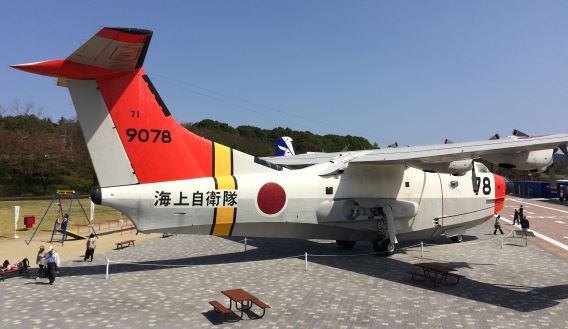

(Oct. 2000) The P-2J stands guard in front of the IKEA store-like museum building. Delivered to the JMSDF on January 27, 1979, 4782 was withdrawn from service with the 7th Fleet Air Sqn and ferried from Kanoya to Gifu AB on May 26, 1994. The faded tailfin and gradual deterioration were rectified in November 2006, when an intricate structure to assist repainting was placed around the aircraft; the work was completed around six weeks later, on December 16, 2006.
(Apr. 2018) The exterior of the museum is essentially unchanged; the red structure is the staircase up to the observation deck, which is accessible at no extra charge from inside the building only. Judging by the condition of the paint on the tailfin, the P-2J is once again showing signs of being in need of some TLC. Perhaps one fundraising idea might be for the museum to initiate an ‘adopt an aircraft’ campaign, though the P-2J would likely lose out to the US-1A on account of the latter’s closer affinity and contributions to society in the form of search and rescue missions.
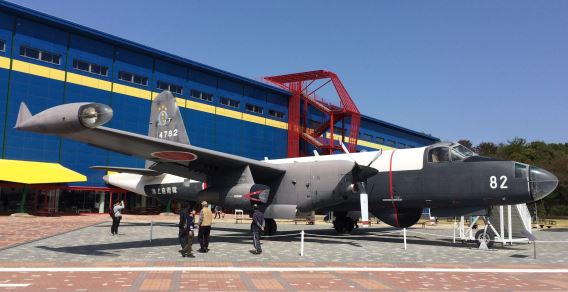
Future Prospect Flights of Fancy
It will be interesting to see how the new-look museum sustains its post-refurbishment momentum and generates the all-important repeat visits, certainly at a greater frequency than J-HangarSpace’s twice in 17 years.
Despite the increase in floor area, however, there seems little room for any major additional acquisitions. The second prototype T-1 is likely to be kept behind the scenes while the existing T-1B remains available on loan, but an ex-JMSDF KM-2 (6255) is also known to be in storage and could at some stage occupy the space next to the KAL-1.
 Seen at Ozuki in May 1978, the KM-2 nearest the camera is currently, some 40 years later, in a
Seen at Ozuki in May 1978, the KM-2 nearest the camera is currently, some 40 years later, in a
dismantled state in storage at the Gifu-Kakamigahara Air and Space Museum. First delivered in
May 1965, this aircraft was struck off charge 15 years later and then spent some time on display
at the Tokyo Metropolitan College of Aeronautical Engineering. (Photo: Takao Kadokami)
To maintain the Kawasaki connection, it would be expected that the museum would ultimately acquire and make room for a T-4 and even a real OH-1. The outside space vacated by the Alouette III could be adjusted to make way for a Kawasaki-built P-3C Orion as a matching bookend for the P-2J; at the very least a P-3C nose section could be housed in an indoor display.
Alternatively, to maintain the close connection with the Air Development & Test Wing across the way at Gifu AB, the last operational home for five of the aircraft, a popular choice would be an F-4EJKai Phantom. Although first flown in January 1971, the first aircraft was still operational with the unit until the summer of 2017, during the museum’s closure. The location next to an active air base remains a good selling point; an AD&TW Phantom seen banking after takeoff during J-HangarSpace’s visit was an impressive sight for all who witnessed it.
 In late 2014/early 2015, the first JASDF Phantom was painted in a subdued special marking to mark the
In late 2014/early 2015, the first JASDF Phantom was painted in a subdued special marking to mark the
60th anniversary of the Air Development & Test Wing. A prime candidate for preservation and perhaps
ultimately destined to join the Mitsubishi Heavy Industries collection, the aircraft was still being flown
from Gifu in November 2019 . (Photo: David Draycott)
Additions to Aircraft Exhibits by Year since 1996
| 1998 | T-33A | 2004 | OH-6J | 2014 | T-2CCV |
| 2001 | BK117P-5 | 2007 | T-1B | 2014 | KAL-1 |
| 2003 | KAT-1 | 2008 | T-3 |
As shown in the above table, on past evidence the addition of a new ‘big ticket’ aircraft exhibit will of course be quite a rare event.
Going Back in Time: Kakamigahara Aerospace Museum, October 2000
Here J-HangarSpace offers a brief look back at the content and layout of the previous museum.
 The replica of the Type 2 Model 1 Reconnaissance Aircraft was mounted on a sloping stage in the
The replica of the Type 2 Model 1 Reconnaissance Aircraft was mounted on a sloping stage in the
entrance hall, which was then called the Welcome House, with a back-projected video showing a
history of Kawasaki aircraft. This area was used to highlight how Kakamigahara developed as an
‘aircraft city’ as a result of first the siting of the airfield and then the arrival of its aviation industry.

As can be seen in the fold-out leaflet published in June 2000 (above), the main display area was then just long enough to accommodate the Asuka and UF-XS facing in opposite directions—the helicopter exhibits were fanned out in front of them—with the Starfighter and T-33A tucked against the far wall. Including the Grade monoplane replica that is now suspended from the ceiling, other exhibits were squeezed in wherever they could safely be positioned. The manga and anime artist Leiji Matsumoto* was appointed the museum’s honorary curator.
 The UF-XS boundary layer control system testbed in its October 2000 location
The UF-XS boundary layer control system testbed in its October 2000 location
 The F-104J was easy to photograph at the back of the Display Area.
The F-104J was easy to photograph at the back of the Display Area.
Also located on the ground floor, a workshop allowed visitors the chance to see renovation and maintenance work in progress. A second-level Flight Simulation Hall that housed six types of virtual reality simulator, offering experiences ranging from hang-gliding to space travel via a flight with the Blue Impulse display team, also provided a good vantage point for photography.


 Helicopter huddle. From left to right: OH-X mockup; OH-6J used to test a bearingless rotor system;
Helicopter huddle. From left to right: OH-X mockup; OH-6J used to test a bearingless rotor system;
Kawasaki KH-4; KHR-1 rigid-rotor helicopter; and the second prototype BK117 that had
been used for structural testing and has since been removed from display.
The subjects that are now covered in the opening exhibit, such as the early pioneers and aviation developments in Japan, formed part of what was then called the Theme House. Other displays covered the theory of flight, and how aero-engines work was illustrated by means of cutaway models. It was here, too, that visitors could sit in an ex-JGSDF OH-6J cockpit linked to captive models that would replicate control inputs; remaining just as popular today, this exhibit has passed the test of time with flying colours.
 Cover of museum guide, published June 2000
Cover of museum guide, published June 2000
* Leiji Matsumoto passed away at the age of 85 in February 2023.
Parting Shot, October 2000

Fast forward more than 17 years, when it came to pass that this major facility showed off its new look to the public for the first time in March 2018. As is usually the case, the estimated costs had ballooned from 3.0 billion yen in 2015 to nearly 4.89 billion yen (roughly US$47 million).
At the time of the 20th anniversary in 2016, current museum director Atsuhiro Nagaura announced that 3.2 million people had visited over those years and highlighted the arrival of two new aircraft (the T-2CCV and KAL-1) since the 15th anniversary; the number of aircraft in the collection grew from 24 to 37 during its previous existence, but now stands at 43. (This report does not include mention of the other light aircraft types and gliders present.).
This time around, a busy Nagaura found time to be interviewed for an article published in the April 2018 issue of the local magazine, Tanton, under the wordy title that translates as Aiming for a Museum Able to Provide an Overview of the History of Aerospace Technology, which was actually taken from the basic concept document produced by Gifu Prefecture and the City of Kakamigahara in September 2015. Nagaura said the museum was structured in a way that facilitates telling the stories of the pioneers and showcasing the history of the many designers and technicians who have confronted the challenges presented by the sky and space.
The museum is hoping for an annual footfall of upwards of 500,000 visitors of all ages; back in 1996, 43,500 visited in the first eight days.
Conversely, despite that long article title, part of the rebranding process has involved making the ‘reborn’ facility more widely known simply as Sorahaku, short for ‘aviation museum’ and a lot easier to say than the official 15-character Japanese name.
 The enlarged Sorahaku building now proudly sports its new name and logo.
The enlarged Sorahaku building now proudly sports its new name and logo.
Aside from the desire to renovate an aging facility to boost visitor numbers and thus revenue, the magazine article states that a key factor had been the Japan External Trade Organization’s designation of the Gifu region as a Special Zone to Create Asia’s No.1 Aerospace Industrial Cluster in 2013. The prefectural authorities saw the need to work in conjunction with Kakamigahara in aiming for growth as an aerospace catchment area and to ensure the supply of workers and managers for the industry in the years to come.
Under those circumstances, one part of the plan involves providing an environment in which to nurture children interested in learning about aerospace. Thus the joint prefecture-city museum renovation project sought to enhance the museum’s functions. The focus remains on the regular staging of special events and educational activities to attract the bread-and-butter visitors, namely families and especially children. The child making paper aircraft and launching water rockets today is the engineer of tomorrow.
Parting Shots, April 2018
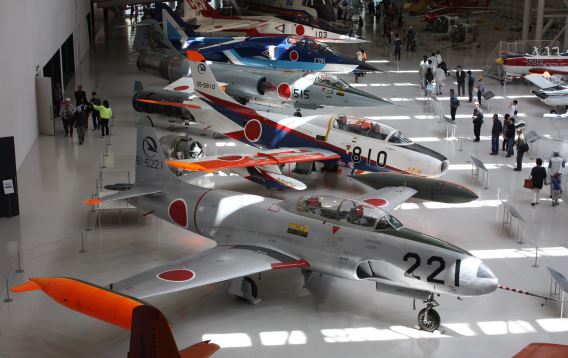
 (The translation of an article on this Hien and details of its history and restoration follow the museum information and book review.)
(The translation of an article on this Hien and details of its history and restoration follow the museum information and book review.)
|
Gifu-Kakamigahara Air and Space Museum 5-1 Shimokiri-cho, Kakamigahara City Gifu Prefecture 504-0924, Japan Tel: +81 58-386-8500 / Fax: +81 58-386-9912 Website: http://www.sorahaku.net (Relies on computer-generated translations) |
||||
| Opening Hours | 10:00 am to 5:00 pm (weekdays) 10:00 am to 6:00 pm (weekends and national holidays) |
|||
| Days Closed | First Tuesday of every month (the following day if that falls on a national holiday) / December 28 to January 2 Check the calendar for the days when closed for maintenance (link) |
|||
| Getting There and Back | ||||
| By Car | Located 7 km from the Gifu-Kakamigahara interchange (IC) on the Tokai-Hokuriku Expressway | |||
| By Public Transport | The nearest station is Kakamigahara-Shiyakusho-mae (Kakamigahara City Hall) on the Meitetsu Kakamigahara Line, from where Fureai community buses (Inaha or Kawashima routes, 100 yen flat fare) stop at the museum. | |||
| By Taxi | Depending on traffic, the journey from Kakamigahara City Hall station will take around 15 minutes and cost around 1,700 yen. The taxi company located closest to the station is Nihon Taxis (058 382 3215). If needed, there is a public phone located round to the left as you enter City Hall. |
|||
 The return bus timetable (as at April 2018); the top (white) schedule applies on weekdays, the bottom
The return bus timetable (as at April 2018); the top (white) schedule applies on weekdays, the bottom
(pink) on weekends and national holidays. Routes 5 and 6 both head for Kakamigahara-Shiyakusho-
mae (Kakamigahara City Hall) station, on the Meitetsu Kakamigahara Line,
but Route 6 makes the journey in around half the time (14 mins).
 (Photo [Nov. 2021]: Gifu-Kakamigahara Air and Space Museum via Twitter @SORAHAKU324)
(Photo [Nov. 2021]: Gifu-Kakamigahara Air and Space Museum via Twitter @SORAHAKU324)
Want to Know More?
 Kōkūki wo Kōsei ni Nokosu (Leaving Aircraft for Posterity)
Kōkūki wo Kōsei ni Nokosu (Leaving Aircraft for Posterity)
by Shintarō Yokoyama
Published by Grand Prix Publishing (Japan), May 2018
ISBN: 978-4-499-87687-356-2; Softback
Japanese text, 208mm×148mm, 272 pp
2,400 yen (excl. tax)
http://grandprix-book.jp/
Published to coincide with the museum’s reopening and subtitled ‘museum creation to exhibit domestically produced aircraft that carved their place in history’, this book offers readers of Japanese a behind-the-scenes look at what is now the Gifu-Kakamigahara Air and Space Museum since its inception.
Primarily a publisher of automotive titles, as its name suggests, Grand Prix* is to be congratulated for making available this lengthy account on an off-beat aviation subject. (J-HangarSpace has been informed that there was a lot more information that had to be omitted.)
Writer Shintarō Yokoyama’s credentials are in the field of aerospace engineering, specifically powerplants. More than that, they include working at the National Aerospace Laboratory (now JAXA) of the government’s then Science and Technology Agency on the teams that flight tested the FJR engine and developed the STOL technologies that were incorporated into the Asuka technology demonstrator aircraft in the 1980s. These assignments naturally brought Yokoyama to Gifu AB, which was known as Kakamigahara airfield prior to and during World War II. At the end of the Asuka project, he found it difficult to break away from an aircraft in which he had personally invested so much and was thus glad to cooperate with Kakamigahara city officials who were looking into creating a museum at what is Japan’s oldest existing airfield. Yokoyama was appointed manager of the team promoting the idea of building an aerospace museum in 1993 and was thus heavily involved first-hand in the planning of the facility and the acquisition of the initial exhibits. Having retired from the post of secretary of what was then Kakamigahara Aerospace Museum in 2009, he remains an active member of aircraft preservation committees and an aviation museum advisor.
The red traditional paper band around its cover proclaims that the book contains ‘unknown stories of the founding of Japan’s largest aerospace museum’ and poses two questions: (1) How was it possible to collect extremely rare, domestically produced types, such as test aircraft and prototypes and, (2) What obstacles had to be overcome? One Japanese reviewer was constantly surprised that creating and operating a museum in Japan, particularly a facility dedicated to preserving the nation’s aviation legacy, could be so difficult.
The aircraft acquisition procedures involved is an angle that J-HangarSpace has tried, with varying degrees of success, to address in magazine articles reports on museums both in Japan and the UK. Here, they and many more are covered in the course of the following 11 chapters:
(1) Why did I come to decide to create a museum?
(2) The museum took this form
(3) The museum finally opens
(4) The time up until the aircraft to be displayed in the museum were decided
(5) National Air & Space Museum, Smithsonian Institution visited
(6) Aiming for restoration and building of replicas appropriate for the museum
(7) Aircraft replicas
(8) Aircraft added to the collection after the museum opened
(9) A museum veering off course
(10) Points of view on replicas
(11) Why collect and hand down for posterity?
Just by way of an example, a look through the coverage of the UF-XS acquisition reveals that the aircraft was rescued a mere five days before it was due to be scrapped.
With the exception of the cover’s inner flaps, all photo content is black and white, and images from the early days are largely from the Japan Aeronautic Association collection.
Like all those involved with the establishment and running of the museum itself, Yokoyama has done an admirable job of relating the “how did we get this far” story. Over the course of time, J-HangarSpace will be incorporating some of the background information contained in this worthy volume into the above account.
* Other aviation titles from Grand Prix have included Rekishi no naka no Nakajima Hikōki (Nakajima Aircraft in History), published in 2002.
 View from the roof of the Gifu-Kakamigahara Air and Space Museum
View from the roof of the Gifu-Kakamigahara Air and Space Museum
(Photo: Gifu-Kakamigahara Air and Space Museum Support Volunteers’ blog [link])
Kawasaki Army Type 3 Fighter (Hien) Restoration
The only example extant in Japan of the more than 3,000 fighters of the type built between 1942 and 1945, an Army Type 3 Fighter Hien (Flying Swallow) underwent restoration at the place of its birth in Gifu Prefecture. Following its homecoming and extended stay at the Kawasaki Heavy Industries plant in Gifu, the aircraft now forms the centrepiece of the nearby Gifu-Kakamigahara Air and Space Museum (the former Kakamigahara Aerospace Science Museum rebranded), which was itself closed to undergo extensive renovation from September 2016 before re-opening on March 24, 2018.
 The sole Hien extant in Japan is seen at the time of its makeover at the then U.S. base of
The sole Hien extant in Japan is seen at the time of its makeover at the then U.S. base of
Tachikawa, Tokyo, in 1963. The aircraft was again stripped down, this time for extensive
restoration work, late in 2015. This photo was published in the April 1963 issue of Aireview.
(Photo used by kind permission of SequireySha K.K.)
J-HangarSpace turned to the aircraft’s previous owner, the Japan Aeronautic Association (JAA), and was kindly granted permission by the Aviation Heritage Archive to translate and use photos from an article that appeared in the Summer 2015 issue of the organization’s magazine, Kōkū to Bunka (Aviation and Culture, known in English as Air Forum). The article provides the basis for a look back at the Hien’s postwar nesting and resting places.
Introduction to Article in JAA Air Forum, Summer 2015
The go-ahead has been given to restore the Hien owned by the Japan Aeronautic Association. Carried out with cooperation from Kawasaki Heavy Industries Co., Ltd. (KHI), the work is planned to take about a year from September 2015. [This year, 2016] marks the 75th anniversary of the Hien’s maiden flight [on December 12, 1941] and, and as luck would have it, heralds the 120th anniversary of KHI’s founding as Kawasaki Dockyard Co., Ltd. in 1896.
This article provides an overview of past and present restoration work carried out on the Hien.
Hien Defined
Kawasaki initiated design development of what was to become the Hien in response to an Army directive of 1940. A prototype flew in December 1941, the type entered volume production in 1942 and was in regular service in 1943. The majority of Japanese military aircraft that saw service during World War II were powered by air-cooled radial engines, but the Hien was fitted with the German-designed, liquid-cooled Daimler-Benz DB601 engine, licence-built and further developed by Kawasaki. In the latter half of the 1930s, aircraft powered by liquid-cooled engines that facilitated streamlined fuselage design were developed in the United States and Europe, and the Hien was developed as a result of the influence those designs had on the Imperial Japanese Army.
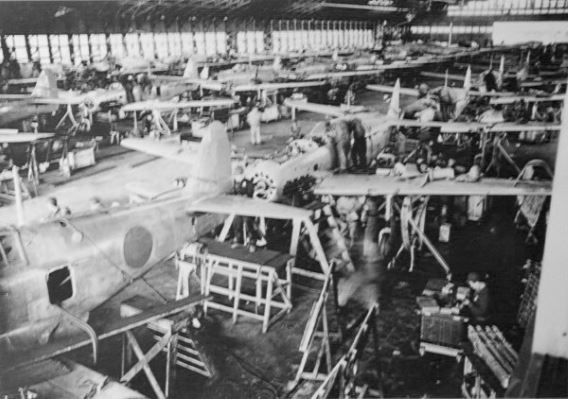 The Hien was the aircraft produced in the greatest numbers at Kawasaki Aircraft’s Kakamigahara
The Hien was the aircraft produced in the greatest numbers at Kawasaki Aircraft’s Kakamigahara
production line. Achieving a peak monthly production rate of 200 aircraft, the plant built
3,285 of the Ki-61 and its modified, radial-engined version, the Ki-100.
(Photo on display at Kakamigahara Aerospace Science Museum)
In charge of design was Takeo Doi (1904–1996), who had studied in the Aviation Department of the Tokyo Imperial University’s Engineering Faculty alongside Jirō Horikoshi (1903–1982), the father of the Mitsubishi Zero fighter. Joining Kawasaki and receiving guidance for a time from aircraft designer Richard Vogt (1894–1979), who had been invited over from his native Germany, Doi exercised his talents in the design of such Kawasaki-built IJAAF aircraft as the Type 95 Fighter (Ki-10) and Type 99 Light Bomber (Ki-48, Lily). In his writings, Doi said of his work on the Hien that it had been his intention to try to put together his ideal fighter aircraft. Involved after the war in the development of the NAMC YS-11 transport and the Kawasaki P-2J Turbo-Neptune anti-submarine warfare aircraft, Doi contributed to the development of Japan’s aircraft industry through his focus on bringing on the next generation of aviation engineers.
 The poster used to publicize a 2014 exhibition at the Kakamigahara Aerospace Science Museum
The poster used to publicize a 2014 exhibition at the Kakamigahara Aerospace Science Museum
that marked the 110th anniversary of Takeo Doi’s birth.
As the Hien entered regular service in 2603 under the Japanese imperial year system, the then standard procedure of taking the last digit as a type number resulted in the Type 3 Fighter designation. As the Army had also adopted a parallel numbering system in 1933 that involved the sequential allocation of kitai (airframe) numbers, the aircraft was also known as the Ki-61. [The name hien conjures up the image of a rapidly turning swallow in flight.]
 A well-known image of a Kawasaki Ki-61 Hien (Ki-61-I Hei) of the 244th Fighter Regiment,
A well-known image of a Kawasaki Ki-61 Hien (Ki-61-I Hei) of the 244th Fighter Regiment,
Imperial Japanese Army Air Force, at Chofu airfield, Tokyo, in May 1945. The former mount
of the unit’s CO, Capt. Teruhiko Kobayashi, “24” was last flown from Chiran, Kagoshima
Prefecture, by 2nd. Lt. Shunzō Takashima on a special (kamikaze) mission against the
U.S. fleet off Okinawa on June 6, 1945.
Surviving the war, Kobayashi joined the JASDF in September 1954 and underwent six
months of jet training in the United States from November 1955. He was one of two
pilots tragically killed when their T-33A crashed on takeoff from Hamamatsu AB,
Shizuoka Prefecture, on June 4, 1957.
The JASDF career of another former 244th CO, Capt. Fumisuke Shōno, included time
flying the F-4EJ Phantom.
(Photo: U.S. Navy National Museum of Naval Aviation via Wikimedia Commons)
It has been reported that around 3,000 aircraft of the type were produced, but few remain and only one of those, the example owned by the JAA, resides in Japan.
History of the JAA Hien
The JAA Hien was captured by U.S. forces at IJAAF Tama airfield (today’s Yokota AB), Tokyo, after the end of the war. During the war, the aircraft is presumed to have been assigned to the Tama-based IJAAF Air Technical Evaluation Unit, but this is not known for certain. Amid the wholesale destruction of practically all Japanese aircraft that remained in Japan after the end of the war, the reason why this aircraft was spared remains unknown. The aircraft is of the Model 2 sub-type, which was designed for improved performance by dint of its Ha-140 engine, Kawasaki’s own development of the DB601. Because of the disrupted production of essential engines, it is reported that fewer than 100 examples were completed to the Model 2 standard.
The San Francisco Peace Treaty was signed in 1951 and came into effect the following year, the year in which the JAA resumed its activities [aviation having been banned during the Allied Occupation]. No records remain of the circumstances under which the Hien was handed over to the JAA from the U.S. military. The JAA displayed the Hien at an exhibition held in Hibiya Park, Tokyo, in 1953 to mark the passing of 50 years since the Wright Brothers’ first flight in a heavier than air aircraft. It was when transporting the aircraft from Yokota to Hibiya Park for the exhibition that the main wing was cut outboard of the flaps to allow for the width of the roads.
 The Hien in Hibiya Park in December 1953, before its outer wings, cut off to enable its
The Hien in Hibiya Park in December 1953, before its outer wings, cut off to enable its
transportation along then narrow roads from Yokota AB, had been reattached as best
as he could by a former IJAAF mechanic. Note also the reportedly jammed engine
crank handle. (Photo from February 1954 issue of The World’s Aircraft used with
permission of Hobun Shorin Co., Ltd.)
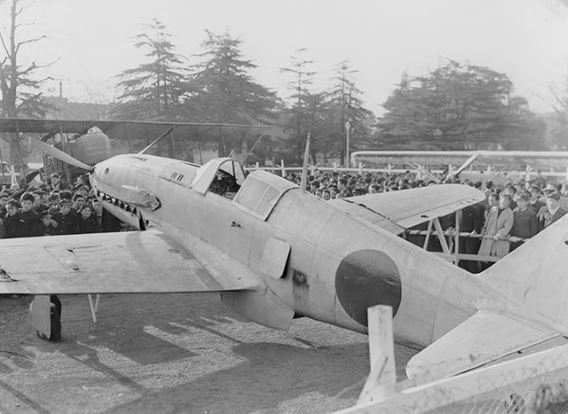 At the time having only recently become the property of the Japan Aeronautic Association, the
At the time having only recently become the property of the Japan Aeronautic Association, the
complete Hien stands in Hibiya Park, Tokyo, at an event marking the 50th anniversary of the
Wright Brothers flight in December 1953. Note the “scars” on the wing.
(Photo: Japan Aeronautic Association)
The Hien was subsequently displayed at exhibitions and air displays throughout the country [details of which can be found in the table below]. In 1986, the aircraft was placed in the then newly opened hall at the Peace Museum for Kamikaze Pilots in Chiran (today part of Minami-Kyushu City), Kagoshima Prefecture, where it was to remain until September 2015.
 The former Hien display at the poignant Chiran Peace Museum for Kamikaze Pilots
The former Hien display at the poignant Chiran Peace Museum for Kamikaze Pilots
(Photo: Japan Aeronautic Association)
Hien’s Present Condition [2015]
It is known that, at the time the JAA Hien came into the U.S. military’s possession, the aircraft was already missing some items, such as the inspection panels on its nose and cockpit instruments. As the subsequent treatment the aircraft received from the JAA was also less than appropriate, interior parts continue to be missing up until today. The cockpit instruments were replaced by similar-looking, U.S.-made versions, and the aircraft fitted with similar-sized, modern-day versions or replicas of other components, including the tyres.
 (Photo: Japan Aeronautic Association)
(Photo: Japan Aeronautic Association)
It is thought that the aircraft had originally appeared in natural metal finish, save for an anti-glare panel and the national markings. The reasoning behind this includes the existence at the JAA of a photo—although not of the same aircraft—that shows a natural metal Type 3 Model 2 (Ki-61-II) assigned to the Air Technical Evaluation Unit at that time, and mention having been made that the JAA Hien had been unpainted at the time it fell into U.S. hands. However, the aircraft underwent maintenance in 1963, during which time a coat of camouflage paint was applied in imitation of an aircraft assigned to the 244th Flying Regiment based at Chofu airfield, Tokyo, during the war. In the case of the aircraft’s interior, the cockpit and the area visible from the access panel directly behind the cockpit had been painted with zinc chromate and other coatings after the war, but the rear fuselage remains in its original, unpainted state.
The Hien Restoration as Aviation Heritage
In recent years, there has been growing interest in cultural properties related to the development of modern industry (industrial heritage) and the modernization of society (modernization heritage) from the Meiji Period (1868–1912) onwards. In 2009, the Hien was selected as part of the Modernization Industrial Heritage Group certified by the Ministry of Economy, Trade and Industry (METI). There is a growing commitment to not merely preserve the appearance of buildings and products, but to try to hand down to future generations as much information as possible in the form of cultural property by saving examples and including input from and about the people who made or used them. Since 2008, the JAA has certified a total of eight important aviation assets, including the first production YS-11 owned by the National Museum of Nature and Science [in Ueno Park, Tokyo]. In addition to the scarcity and position in aviation history of a candidate for certification, important judgment criteria take into account whether and to what extent the aircraft’s original state (originality and authenticity) has been maintained.
The Hien underwent restoration work at the U.S. military base at Tachikawa in 1963, and there are signs that repairs have been carried out on a number of occasions since then. Embarrassingly, no records remain of when and what kind of work was carried out. The work seems to have focused entirely on maintaining the aircraft’s external appearance. At that time, the view had not yet been fostered that aircraft such as the Hien could be seen as cultural assets.
Being carried out on an aircraft seen as a cultural asset to be handed down to future generations, the current restoration work is being regarded as an opportunity to (a) remove the modifications added after the war that are extraneous to the aircraft’s history without undermining original parts, and (b) leave behind detailed records. Involving KHI’s cooperation, the work will more specifically include:
- Inspection of original and non-original parts
- Removal of current paint and re-painting close to original colour scheme
- Re-covering of fabric flying surfaces that were covered after the war
- In the case of missing parts, obtain the same type of parts or, if possible, re-engineer exact replicas
As 70 years have passed since the aircraft was built, an inspection of the aircraft’s structural soundness will be conducted that will check for the presence of corrosion and confirm that there are no obstacles to future storage.
After the restoration, the plan is to exhibit the aircraft at the Kakamigahara Aerospace Science Museum in Gifu Prefecture.
Request for Assistance in Hien Restoration Project
After World War II, a vast amount of aviation-related documentation was destroyed and hardly any on the Hien remains. The team at KHI is currently conducting an extensive inspection of the Type 5 Fighter [Ki-100 radial-engined version of the Hien] preserved [at the RAF Museum Cosford] in England for the purposes of the Hien restoration. Also, Tachihi Holdings Co., Ltd. has provided information on restoring the fabric wing coverings. In addition, assistance is being received from organizations and individuals who possess Hien drawings and handling manuals or know where they are currently being kept. These documents are being copied to serve as an archive for the restoration project.
Having thus far donated items such as a Hien tyre (shown below) and cockpit switches, the JAA Aviation Heritage Archive would if possible like to take advantage of this restoration.
 (Photo: Japan Aeronautic Association)
(Photo: Japan Aeronautic Association)
If anyone reading this possesses Hien photos and parts or relevant documents, we [the JAA Aviation Heritage Archive] would very much appreciate hearing from them.
“Flying Swallow” 6117 Migrations and Sightings
| Sept. 1944 | Manufactured as Model 2 Hien c/n 6117 at Kawasaki Aircraft’s Gifu Plant |
| Early 1945 | Probably assigned to IJAAF Technical Evaluation Unit |
| Sept. 8, 1945 | Found by U.S. forces at Tama (Fussa) airfield (now Yokota AB), Tokyo |
| 1946–1953 (Yokota AB) |
On display at official handover of Yokota AB to occupying forces, Aug. 8, 1946. Aircraft remains on display close to Base Operations Building (the wartime Fussa airfield control tower). Sports U.S. markings for a time from 1947. Following a barracks fire, moved to in front of base gymnasium |
| 1953–1963 (JAA) |
Ownership transferred from U.S. military to Japan Aeronautic Association (JAA). Displayed at event marking 50th anniversary of Wright Brothers flight in Hibiya Park, Tokyo (Dec. 1953), after which placed in store at Ministry of Transport, Infrastructure, Transport and Technology Institute in Mitaka, Tokyo Displayed in increasingly dilapidated state at: Travel and tourism event marking 30th anniversary of the start of streetcar operations in Kumamoto (Oct.-Nov. 1954) Nagoya event raising money for castle reconstruction (early 1955) Yatsu Play Land amusement park in Narashino, Chiba Prefecture (c. 1955) Kintetsu Ayameike Amusement Park, Nara Prefecture (March-May 1956) |
| Dec. 12, 1962 | Handed over at Mitaka to U.S. 5th Air Force for restoration at Tachikawa, Tokyo. Designer Takeo Doi involved in restoration work |
| Mar. 16, 1963 | Officially handed back to JAA President Taizō Shōda at ceremony on first day of Tokyo Air Pageant held at Futako-Tamagawa Park. JAA requests that Japan Defense Agency (JDA) assume responsibility for storage immediately after pageant ends on May 31 |
| May 31, 1963 onwards JDA (now Ministry of Defense) |
Responsibility for storage and maintenance passes to Gifu AB (where aircraft appears at annual air show in 1971–1975, 1977–1978, 1985) 1963 plans for display at Yasukuni Shrine in Tokyo abandoned, aircraft hastily transported to Kumagaya AB, Saitama Prefecture. Aircraft also shown at: Takarazuka, Hyogo Prefecture, in spring of 1964 Third air show at Iruma AB, Saitama Prefecture, marking JASDF’s 10th anniversary, Nov. 3, 1964 Kumagaya AB Open House (in hangar), March 1965 Keio department store at Shinjuku Station, Tokyo, coinciding with exhibition of war memorabilia, summer 1965 Hanshin department store (on roof) in Osaka, October 1965 Defence exhibition near Himeji Castle, Hyogo Prefecture, with JASDF aircraft, April-June 1967 Aeronautical Science Fair, YomiuriLand Amusement Park, Tokyo, Mar.-May 1968 Second Tokyo Aerospace Show, Iruma AB, October 1968 Gifu AB (long-term display) 1970 to March 1972 Great Aviation Exhibition, Imabari, Ehime Prefecture, March-June 1972 Festival in Sakae Park, Nagoya, Aichi Prefecture, May 1973 Shizawa department store (on roof), Fujisawa, Kanagawa Prefecture, April-May 1975 International Aerospace Show, Iruma AB, October 1976 Natalie Amusement park air fair, Hiroshima Prefecture, May 1978 Inuyama Line Park air fair, Aichi Prefecture, Sept.-Nov. 1979 Mitsui Greenland Amusement park air fair, Kumamoto Prefecture, March-June 1980 Mitsukoshi department store aviation exhibition (sponsored by JAA, backed by Asahi Shimbun), Ikebukuro, Tokyo, July-Sept. 1980 Sky Festival, Okegawa airfield, Saitama Prefecture, August 1981 and August 1983 (For around two years in the 1980s, the aircraft was suspended from the ceiling at the Kawaguchiko Motor Museum in Narusawa, Yamanashi Prefecture. J-HangarSpace has contacted museum owner Nobuo Harada, who hopes to provide more information when able to access his currently [Feb. 2016] snowbound facility.) |
| 1986 | After 23 years, JDA loans aircraft to Peace Museum for Kamikaze Pilots, Chiran, Kagoshima Prefecture |
| 2009 (JAA) | Aircraft selected as METI-certified aviation heritage asset |
| Sept. 8, 2015 | After 29 years in Chiran, now 71-year-old aircraft arrives at KHI’s Gifu plant for restoration work |
| Mar. 24, 2018 | Goes on open public display at what is now the Gifu-Kakamigahara Air and Space Museum |
| Sources: Japanese, primarily Hikōki Kumo (Contrail) Internet magazine (link) |
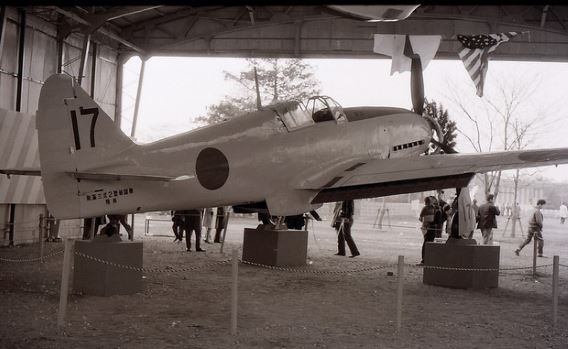
(Above and below) Two views of the Hien, taken 13 years apart by the same photographer. That above shows the aircraft during the final days of its first period under Japan Aeronautic Association ownership, at the Tokyo Air Pageant of 1963. Below, the aircraft stands next to a Zero fighter on Iruma’s wet tarmac during the International Aerospace Show of October 1976. (Photos: Jun Oizumi)
(To view more of Jun Oizumi’s collection, please visit his contribution page at
1000aircraftphotos.com [link])

 In 1980, the Hien was displayed next to a JASDF Starfighter outside the Mitsukoshi department store in Ikebukuro, Tokyo, as part of an aviation exhibition. At that time, the aircraft was painted in less flamboyant 244th Flying Regiment markings than those applied for its long-term stay in Chiran.
In 1980, the Hien was displayed next to a JASDF Starfighter outside the Mitsukoshi department store in Ikebukuro, Tokyo, as part of an aviation exhibition. At that time, the aircraft was painted in less flamboyant 244th Flying Regiment markings than those applied for its long-term stay in Chiran.
(Photo: Keiichi Yamada, as published in his book Hikōki Hyakunen
[A Century of Airplanes], Seizando, 2007)
 Looking somewhat out of place, the Hien spent a couple of years suspended from the ceiling at the
Looking somewhat out of place, the Hien spent a couple of years suspended from the ceiling at the
Kawaguchiko Motor Museum, which was built in 1981. Interestingly, what appears to be the
fuselage of a Nakajima Ki-115 Tsurugi (Sword)—presumably the example that, like the Hien,
was displayed at Yokota AB—can be seen shelved in the background. A report on a 2014
visit to the adjoining Zero Fighter Museum (Kawaguchiko Aviation Hall) can be found
in the Aviation Museum Reports section below.
(Photo: Kawaguchiko Motor Museum via Nobuo Harada)
 Another view of then gaudily painted, dummy drop tank-equipped Hien 6117 during its long,
Another view of then gaudily painted, dummy drop tank-equipped Hien 6117 during its long,
29-year residency at the Chiran Peace Museum. Removed in the early 1970s, its Ha-40
engine was displayed alongside the aircraft.
 (Photos [July 2009]: Goshimini via Wikimedia Commons)
(Photos [July 2009]: Goshimini via Wikimedia Commons)
More recent information on the restoration project was provided in the February 2016 issue of JWings magazine, as a result of the press having been granted access to witness the status of the project late in 2015.
The JAA commenced this restoration project to preserve the aircraft for posterity in May 2015. The main wing proving a tight fit for one of the three truck trailers used for the three-stage nighttime road journey from Chiran, the aircraft arrived in Gifu on September 8 for work to begin in earnest in a corner of the KHI plant. The Kakamigahara City website carried a report following a media event held 10 days later, at which a banner behind the aircraft proclaimed Army Type 3 Fighter Hien Returns Home!
By the end of November 2015, the main wing had been separated from the fuselage, and the gaudy camouflage scheme and 244th Flying Regiment markings the aircraft had worn throughout its time at Chiran removed. This enabled the original Kawasaki parts and later attempts at repairs to be clearly seen. Prior to taking up residency at Chiran, the aircraft had taken a lot of punishment during its time being transported around Japan and when placed on display at a number of locations.
KHI established a 25-strong Hien Restoring Engineering Team (HiRET) to oversee this important undertaking with the aim of carrying out the work, as far as is possible, on the basis of accurate historical research. A report in the Gifu Shimbun daily on September 19, 2015, quoted Takashi Ninomiya, the deputy HiRET leader, as saying: “We would like to restore the aircraft to as near as possible to its appearance at the time it was built, while conveying the complexity of the manufacturing process and the extent to which technology had progressed.”
A large number of Japanese companies are taking part in the project by reproducing missing parts. At the time of the JWings visit, the restoration work was expected to have been completed in autumn 2016 to enable the aircraft to take pride of place at the nearby Kakamigahara Aerospace Science Museum in November, but a joint Gifu Prefecture-Kakamigahara City initiative to refurbish the museum meant that the aircraft would have to be carefully kept in temporary accommodation elsewhere.
Upon completion of its initial restoration, the aircraft was presented to the media at an event marking Kawasaki’s 120th anniversary held at Kobe Port Terminal on October 16, 2016; a series of photos from the Sankei Shimbun can be found here (link) and a YouTube clip here (link). The aircraft remained on public display there until November 3 and was then transferred back to the Gifu Works.
Even before the aircraft’s homecoming, the name Hien had made headlines following a succession of local finds. Discoveries in a farmer’s attic in September 2014 and at an elementary school in nearby Unuma in May 2015 had yielded a propeller spinner from an earlier Model 1 and parts from a Hien’s lower fuselage. Measuring 57 cm high and 64 cm in diameter, the duralumin spinner retains both its dark “Kawasaki green” paint and dark brown primer. The items are believed to have come into local people’s possession and changed hands for unknown reasons amid the postwar turmoil, when materials were scarce.
No less a dignitary than Kakamigahara City Mayor Kenji Asano presented details of the finds at a press conference held on July 24, 2015. Quoted by the Gifu Shimbun daily the next day, the head of the city’s History and Folklore Museum Katsuhiro Nishimura stressed that “Few Kakamigahara citizens are today aware that the Hien was mass produced here during the war. Having such items is worthwhile, as they will help people gain some first-hand experience [by means of genuine items] and realize that aircraft production once thrived here.”
Donated to the city, the spinner formed part of a temporary exhibit held at the Kakamigahara Foundation for Culture and Industry in August 2015 to mark the 70th anniversary of the Pacific War’s end.

![]()


